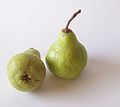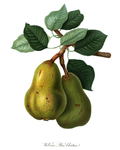Pyrus communis
Pyrus communis, commonly known as the European pear or common pear, is a species of pear native to central and eastern Europe and southwest Asia. It is one of the most important fruits in the world, both for its nutritional value and its widespread cultivation.
Taxonomy[edit]
The scientific name Pyrus communis was first described by Carl Linnaeus in his landmark 1753 work Species Plantarum. The genus name Pyrus comes from the Latin word for "pear tree", while communis means "common" in Latin.
Description[edit]
Pyrus communis is a deciduous tree that can grow up to 20 meters in height. The leaves are alternately arranged, simple, 2–12 cm long, glossy green on top, and slightly paler below. The white to pinkish flowers are produced in early spring before the leaves.
Cultivation[edit]
The cultivation of Pyrus communis dates back to prehistoric times. Today, it is grown in all temperate-zone countries of both hemispheres. The tree is harvested from late summer to mid-autumn. The fruit is consumed fresh, canned, as juice, and dried.
Varieties[edit]
There are thousands of cultivars of Pyrus communis available, including 'Bartlett', 'Bosc', 'Anjou', and 'Comice'. Each variety has its own unique flavor, texture, and color.
Uses[edit]
In addition to being consumed as a fruit, Pyrus communis is also used in cooking, baking, and in the production of alcoholic beverages such as perry.
Health Benefits[edit]
Pears are a good source of dietary fiber and vitamin C. They also contain small amounts of vitamin K, vitamin B2, and potassium.
See Also[edit]
Pyrus communis[edit]
-
Pears
-
2015 Kwiatostan gruszy pospolitej
-
Kruška Rana Moretini - mali plodovi
-
Blake's Pride pears
-
Pear peckham 78
-
Clairgeau
-
Guteluise
-
Pear pie
-
Williams Bon Chrétien 1822
-
Pomological Watercolor POM00006921
-
Pomological Watercolor POM00006920
-
Poires williams Vertes et Rouges Savoie
Ad. Transform your life with W8MD's Budget GLP-1 injections from $75


W8MD offers a medical weight loss program to lose weight in Philadelphia. Our physician-supervised medical weight loss provides:
- Weight loss injections in NYC (generic and brand names):
- Zepbound / Mounjaro, Wegovy / Ozempic, Saxenda
- Most insurances accepted or discounted self-pay rates. We will obtain insurance prior authorizations if needed.
- Generic GLP1 weight loss injections from $75 for the starting dose.
- Also offer prescription weight loss medications including Phentermine, Qsymia, Diethylpropion, Contrave etc.
NYC weight loss doctor appointmentsNYC weight loss doctor appointments
Start your NYC weight loss journey today at our NYC medical weight loss and Philadelphia medical weight loss clinics.
- Call 718-946-5500 to lose weight in NYC or for medical weight loss in Philadelphia 215-676-2334.
- Tags:NYC medical weight loss, Philadelphia lose weight Zepbound NYC, Budget GLP1 weight loss injections, Wegovy Philadelphia, Wegovy NYC, Philadelphia medical weight loss, Brookly weight loss and Wegovy NYC
|
WikiMD's Wellness Encyclopedia |
| Let Food Be Thy Medicine Medicine Thy Food - Hippocrates |
Medical Disclaimer: WikiMD is not a substitute for professional medical advice. The information on WikiMD is provided as an information resource only, may be incorrect, outdated or misleading, and is not to be used or relied on for any diagnostic or treatment purposes. Please consult your health care provider before making any healthcare decisions or for guidance about a specific medical condition. WikiMD expressly disclaims responsibility, and shall have no liability, for any damages, loss, injury, or liability whatsoever suffered as a result of your reliance on the information contained in this site. By visiting this site you agree to the foregoing terms and conditions, which may from time to time be changed or supplemented by WikiMD. If you do not agree to the foregoing terms and conditions, you should not enter or use this site. See full disclaimer.
Credits:Most images are courtesy of Wikimedia commons, and templates, categories Wikipedia, licensed under CC BY SA or similar.
Translate this page: - East Asian
中文,
日本,
한국어,
South Asian
हिन्दी,
தமிழ்,
తెలుగు,
Urdu,
ಕನ್ನಡ,
Southeast Asian
Indonesian,
Vietnamese,
Thai,
မြန်မာဘာသာ,
বাংলা
European
español,
Deutsch,
français,
Greek,
português do Brasil,
polski,
română,
русский,
Nederlands,
norsk,
svenska,
suomi,
Italian
Middle Eastern & African
عربى,
Turkish,
Persian,
Hebrew,
Afrikaans,
isiZulu,
Kiswahili,
Other
Bulgarian,
Hungarian,
Czech,
Swedish,
മലയാളം,
मराठी,
ਪੰਜਾਬੀ,
ગુજરાતી,
Portuguese,
Ukrainian












